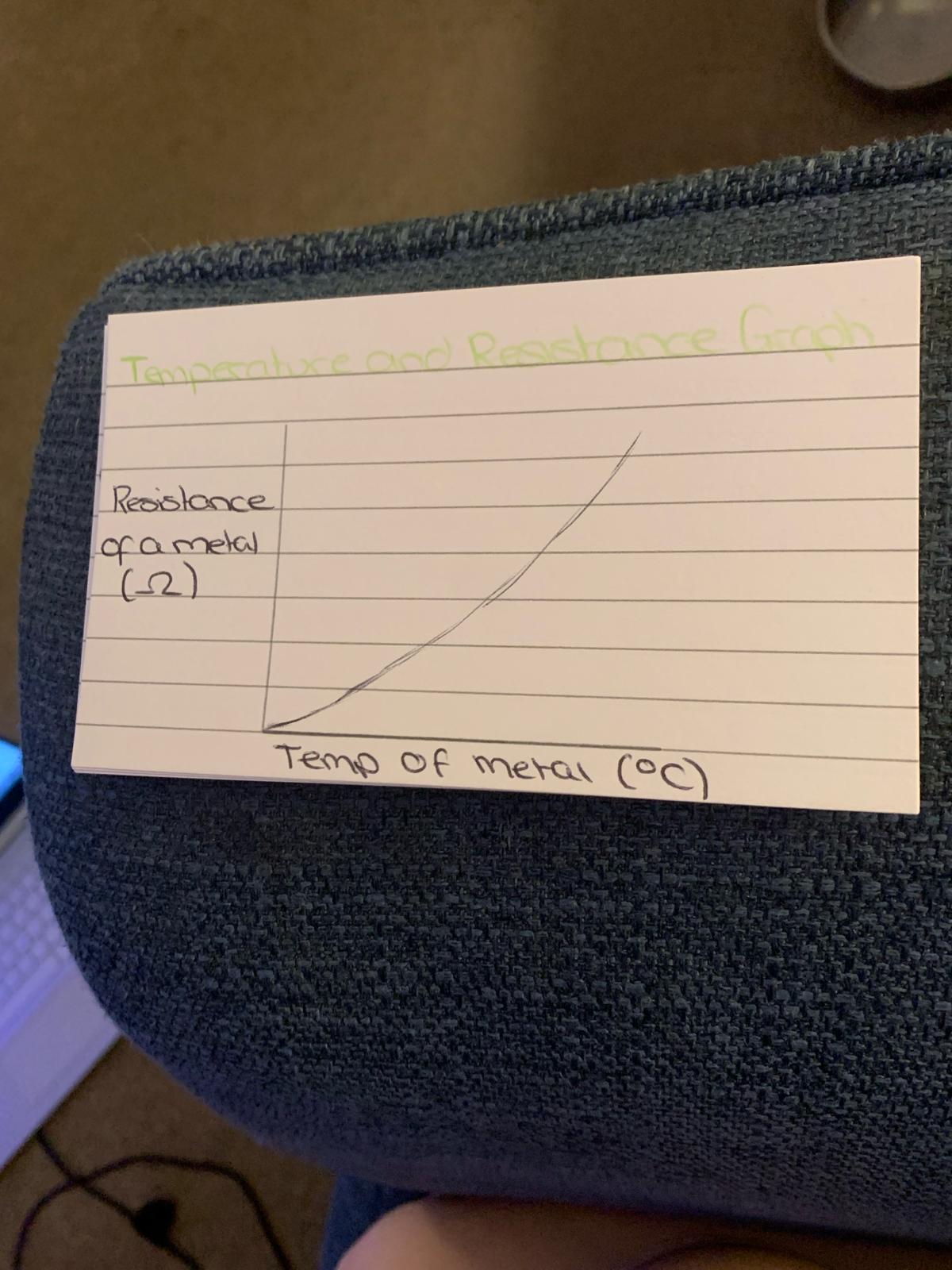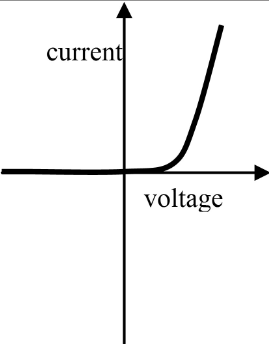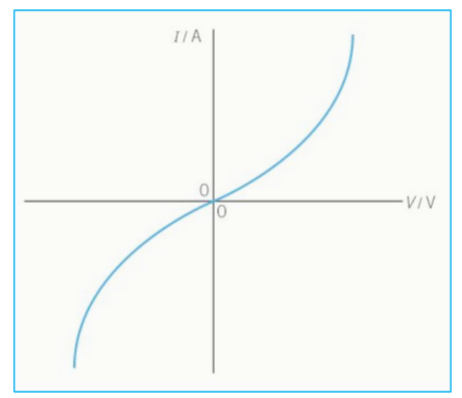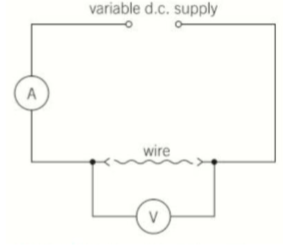4.2: Energy, Power, and Resistance
1/51
Earn XP
Description and Tags
Name | Mastery | Learn | Test | Matching | Spaced |
|---|
No study sessions yet.
52 Terms
What is resistance
Opposition to flow of electric current in component
Definition of resistance
The resistance of a component is the voltage across the component divided by the current flowing through the component
Equation for resistance
V=IR
Ohm as a unit
1 Ohm is the resistance of a component when a potential difference of 1 volt is produced per ampere of current
Ohm’s Law Definition
For a metallic conductor at a constant temperature, the current in the conductor is directly proportional to the potential difference across the component
Temperature and resistance
In a circuit, the current will decrease over time because the heating caused by the current causes the temperature of the wire to increase over time, which increases the resistance over time.

Microscopic explanation of resistance
Temp wire increases
Positive ions inside wire have more internal frequency
Vibrate with a greater amplitude
Frequency of collisions between the charge carriers and metal ions increases
More energy is transferred from the electrons, which heats the wire
What is an Ohmic component
Component that follows Ohm’s Law
I-V Characteristics: Resistor
Opposes flow of current
P.D directly proportional to current
Ohmic component
Resistance always constant
Behaves same way despite polarity

I-V Characteristics: (Filament) Lamp
Emits light
P.D and current aren’t directly proportional
Doesn’t obey Ohm’s law
Resistance isn’t constant
Behaves the same way despite polarity

I-V Characteristics: Diode/LED
Allows current to flow in one direction
Used in standby circuits
P.D and current are not directly proportional
Behaviour depends on polarity
Resistance isn’t constant
Doesn’t obey Ohm’s Law

I-V Characteristics: Thermistor
Changes resistance depending on temperature
Used in thermostats
As the temperature increases, the resistance decreases
used to monitor temp in ovens and engines, and to measure temperature in electrical devices
NEGATIVE TEMPERATURE COEFFICIENT

I-V Characteristics: Light Dependent Resistor (LDR)
Allows us to monitor light intensity of surroundings
Made of semiconductors
Used in smart phones to detect surrounding light
Resistance decreases as light intensity increases

Negative Temperature Coefficient (NTC)
Property of materials that experience a decrease in electrical resistance when the temperature is raised
(Example of a component is a thermistor)
Positive Temperature Coefficient (PTC)
Refers to materials that experience an increase of electrical resistance when their temperature is changed
Method to determine I-V Characteristics
Set up components in one of the circuits (see f/c in fact sheet pack)
Add ammeter in series and voltmeter in parallel
Alter resistance (w variable resistor or potentiometer) to obtain a range of voltages across and currents through the component
Repeat readings several times (ensures reliable results)
Plot a graph with current on y-axis and voltage on x-axis
What is resistivity
A constant used to remove the proportionality between 1) length and resistance and 2) ross sectional area and resistance
Equation for resistivity
R=pL/A
R= resistance (Ω)
p= resistivity (Ωm)
A= cross sectional area (m2)
L= length (m)
How resistivity is defined
Resistance multiplied by cross sectional area divided by length, at a constant temperature
Variation of resistivity with temperature
Conductors: Resistivity increases with an increase in temp (PTC)
Insulators and semiconductors: Resistivity decreases with increase in temp (NTC)
Method for determining resistivity
Measure diameter of the wire with a micrometer at multiple places along the wire and find and average
Determine area of wire using A=πr2
Using circuit attached measure the current and P.D for various different lengths (regular intervals, measured with by a ruler)
Calculate resistance for each length R=V/I
Plot a resistance against length and graph and use y=mx+c analysis to determine resistivity
Multiply by gradient by cross-sectional area to determine resistivity

Definition of Power
Power is the rate of energy transfer
Unit of Power
Watts, W
Equation for Power with electrical energy tansferred
P=W/t
W= electrical energy transferred (J)
t= time (which energy is being transferred) (s)
Equation for Power with Voltage
P=VI
V= potential difference (V)
I= current (A)
Equation for Power with current2
P=I2R
R= resistance (Ω)
I= current (A)
Equation for Power with voltage2
P=V2/R
V= potential difference (V)
R= resistance (Ω)
Equation for calculating energy transferred in a given time
W=VIt
W= electrical energy transferred (J)
t= time (s)
V= P.D (V)
I= current (A)
What is the Volt?
A reading that indicates energy transfers across a circuit
What determined the type of energy transfers across a circuit/component?
If the voltage measures a potential difference or electromotive force
Required definition for the volt
One volt is measured across a component when one Joule of energy is transferred per one Coulomb of charge passing through the component
The voltmeter
Measures P.D
Always in parallel
Ideal: has infinite resistance, so no current passes through it
Potential difference definition
The energy transferred from electrical energy to other forms per unit of charge (Volts)
Equation for potential difference
W=VQ
W= energy transferred by charge Q (J)
V= potential difference (V)
Q= charge (C)
potential difference measures
Electrical energy lost in a circuit
Potential difference location
Across a component
Energy transfer of potential difference
Electrical —> something else
Electromotive force (emf) definition
Energy transferred from a source to electrical energy from some other form per unit charge (volts)
Equation for emf
W=εQ
W= energy transferred by charge (Q)
ε= electromotive force (V)
Q= charge (C)
EMF measures
Electrical energy gained in a circuit
Where emf is found
The power supply
Energy transfer of emf
Some other store —> electrical energy
Equation of energy transfer for charged particles
eV=1/2mv2
e= elementary charge for required particle (C)
V= potential difference (V)
m= mass for required particle (kg)
v= velocity of particle (ms-1)
What is an electron gun
An electrical device used to produce a narrow beam of electrons
How an electron gun works
A small metallic filament is heated by an electric current. Some of this fives some electrons enough energy to escape the surface of the metal (in a process called thermionic emission)
Thermionic emission
The emission of electrons through the action of heat
What happens when filament of electron gun is placed om a vacuum with a high potential difference that is applied between the filament and the anode
The filament acts as a cathode and free electrons accelerate towards the anode gaining kinetic energy. If the anode has a small hole in it, then electrons in line with this hole can pass through it (creating a beam of electrons)
The kilowatt-hour
Unit of energy
Utility companies measure the electrical energy you use in kWh
Definition of kWh
1 kilowatt-hour is the energy transferred by a device of power rating 1kW in the time of 1 hour
Calculating cost of energy
Cost (pence) = number of kWh used x cost of each kWh (pence)
Distinction between P.D and emf
P.D is loss of electrical energy whereas emf is the gain of electrical energy
P.D happens across components whereas emf happens across the power source
Linear Particle Acceleration (LINAC)
Uses series of cylindrical electrodes to accelerate subatomic particles
The polarity of the drift tube is altered between the +ve and -ve with precise timing so that as the protons leave the tube, polarity changes so they’re attracted to the next one